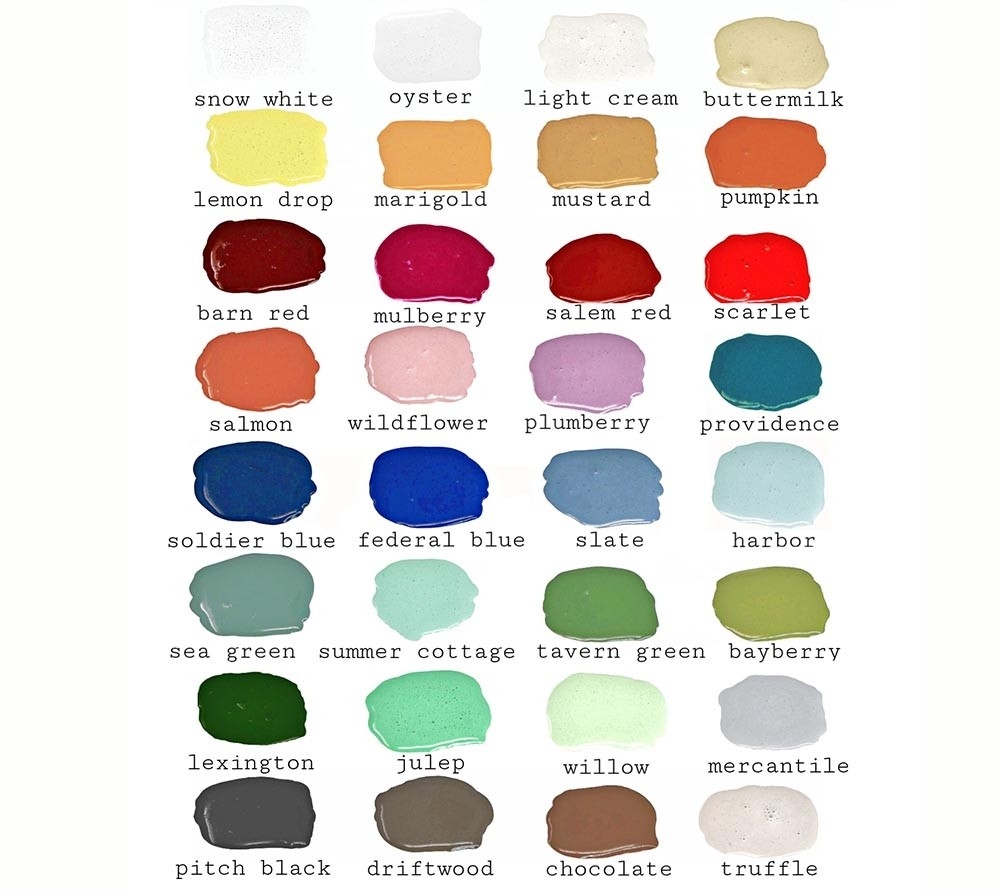Milk Paint is also known in this country as Casein Paint. Casein, a protein component that is also found in milk, is an extremely important binder in Milk Paint. In addition to the included casein, clay, lime, and earth pigments are part of Milk Paint.
The natural Milk Paint is very environmentally friendly and even compostable. Furthermore, it is free from chemical preservatives. Petroleum products are also not used in the colors. Additionally, lead is completely avoided.
Our Milk Paint is excellent for interior walls, floors, and woodwork in homes and offices. It's perfect for those who are allergic or sensitive to colors with chemical ingredients. The uneven, grainy appearance is characteristic of Milk Paints, which is why they are highly sought after and widely used by artists and craftspeople.
With Milk Paint, you can create a vintage or shabby-chic look using simple tools. This authentic, "aged look" is best showcased on furniture, floors, cabinets, signs, toys, and other woodwork. Milk Paint penetrates all clean and porous (i.e., untreated) surfaces, making it particularly popular for wooden elements.
Milk Paint History - A Glimpse into the Past
According to milkpaint.com, Milk Paint has been used by humanity before recorded history. Initially, the paint was used for decorative purposes, and later as a protective coating. The oldest painted surfaces on Earth were mostly coated with a form of Milk Paint. Milk, lime, and earth pigments (components of Milk Paint) were used, for example, in cave paintings around 8,000 years ago. Additionally, drawings and paintings (based on Milk Paint) have been discovered dating back 20,000 years.
In 1924, when the tomb of Egyptian King Tutankhamun was opened, researchers found various artifacts, models of boats, and furniture that were painted with Milk Paint.
Since the original production of Milk Paint was so simple, people relied on the paint for thousands of years - worldwide. Over time, various mixtures emerged, leading to different results in terms of durability. Many of these coatings were weather-resistant, while others dissolved upon contact with water. Some "recipes" included various oils, eggs, or waxes.
It was only over time that the production of Milk Paint evolved. This allowed for a durable coating that was virtually permanent. The colors on the walls in Dendera (Egypt) are so vibrant and intense that they must have been over 2,000 years ago - despite being exposed to the open air for centuries.
11 Advantages of Milk Paint Compared to Other Paints
Milk Paint colors, as you can see, not only have a long tradition but also numerous advantages over other paints. Let's explore these benefits in detail:
- Milk Paint adheres to almost all clean, porous surfaces
- It is environmentally friendly, non-toxic, and antibacterial
- Milk Paint is non-flammable
- It contains no solvents
- The paint dries very quickly
- In its dry state, Milk Paint is odorless
- It is the most durable (known) paint
- Milk Paint is known for deep, rich colors
- The colors can be mixed to create many additional shades and hues
- These are permanent colors that do not fade
- Milk Paint is easy to clean with water
Tips for Proper Use of Milk Paint
Milk Paint is always sold in powder form. This keeps the paint (when sealed) virtually indefinitely shelf-stable. To use the paint, mix the powder with warm water in a 1:1 ratio.
If you add more water, the paint becomes more transparent. This way, you can easily determine the intensity of the color yourself. Our tip: Always mix only as much paint as you actually need. Once diluted with water, the paint will be usable for a maximum of two days. Please note that you should store the remaining (mixed) paint in a sealed container in the refrigerator. The powdered paint, on the other hand, remains shelf-stable for several years when airtight and sealed. It's best to use the mixed Milk Paint fresh, as it's easiest to work with.
When mixing the Milk Paint powder with water, you should thoroughly stir the mixture for about 2-3 minutes and then let it stand for 10-15 minutes to allow everything to dissolve completely. For stirring the paint, a whisk or a beater is recommended. While using the paint, you should stir the Milk Paint color about every 10 minutes. Over time, the paint will become slightly thicker. To counteract this, you can simply add a small splash of water as needed.
The mixed paint can be applied using a brush, a roller, or even a paint sprayer. Natural bristle brushes work well for smaller areas. Foam brushes require less effort and leave fewer brush marks. Our tip: Opt for bristle brushes if you want to give your furniture an antique vintage look. If you prefer a uniform result, you can also use a roller. However, the best result is achieved with a paint sprayer. When using a paint sprayer, the Milk Paint-water mixture should be slightly thinner than for regular painting. Adjust the nozzle pressure so that a good paint film is formed, which is neither too dry nor too wet. Please remember to wear appropriate protection when spraying paint.
If you want to paint porous surfaces such as wood or masonry, you should thoroughly clean the surface first (e.g., with a damp cloth). This removes dust and slightly moistens the surface. Generally, no primer is required in advance, as the first coat of Milk Paint serves as the primer. If you want to apply a second coat, we recommend waiting for about an hour until the paint has dried. Our tip: If the painted surface comes into contact with water, you should definitely seal the paint. While the paint won't completely detach from the surface, unsightly water stains can quickly form.
By the way, you can find environmentally friendly sealants that are suitable for Milk Paint colors on milkpaint.com.
Milk Paint Colors – These are the Colors Available
At American Heritage, there are currently 20 different Milk Paint shades that we have been importing from the USA since 2005. However, the colors themselves can be combined and mixed with each other, allowing you to create endless color variations in the end. Our tip: Mix the colors with "Snow White" to achieve different light shades. You can also control the intensity and opacity of the color by adjusting the amount of water you use for mixing.
What you can look forward to: Soon, American Heritage will have new, beautiful Milk Paint shades, expanding our range to a total of 32 different colors. The new Milk Paint colors will also come in a more modern packaging.





